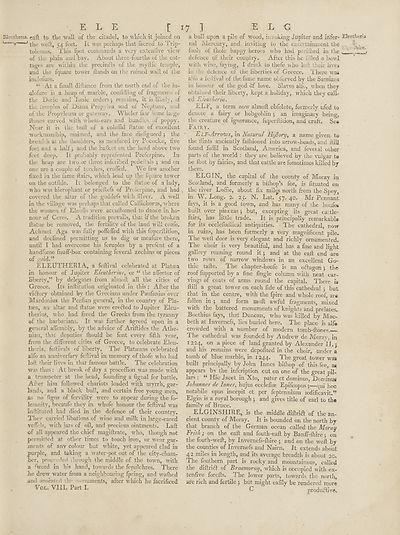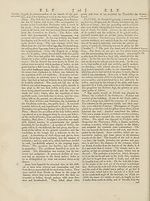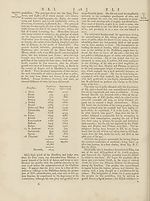Encyclopaedia Britannica, or, a Dictionary of arts, sciences, and miscellaneous literature : enlarged and improved. Illustrated with nearly six hundred engravings > Volume 8, ELE-FOR
(29) Page 17
Download files
Complete book:
Individual page:
Thumbnail gallery: Grid view | List view

. E L E [i
Eleuthena. eaft to the Avail of the citadel, to which it joined on
the weft, 54 feet. It was perhaps that facred to Trip-
tolemus. This fpot commands a very exteniive view
of the plain and bay. About three fourths of the cot-
. tages are within the precinfts of the myftic temple,
and the fquare tower Hands on the ruined wall of the
inclofure.
“ - At a fmall di dance from the north end of the m-
olofure is a heap of marble, coniifting of fragments of
the Doric and Ionic orders; remains, it is likely, of
the temples of Diana Propylea and of Neptune, and
of the Propyleum or gateway . Wheler faw lome large
Hones carved with wheat-ears and bundles of poppy.
Near it is the buit of a coloffal flatue of excellent
workmanihip, maimed, and lire face disfigured ; the
breadth at llie ihoulders, as meafured by Pococke, five
feet and a half 3 and the bafket on the head above two
feet deep. It probably reprefented Proferpine. In
the heap are two or three inferibed pedeftals 5 and on
one are a couple of torches, eroffed. We faw another
fixed in the fame Hairs, which lead up the fquare tower
on the outfide. It belong-ed to the Hatue of a lady,
who was hierophant or prieftefs of Proferpine, and had ,
covered the altar of the goddefs with filver. A well
in the village was perhaps that called Callichorus, where
the women of Eleufis were accuilomed to dance in ho¬
nour of Ceres. A tradition prevails, that if the broken
flatue be removed, the fertility of the land will ceafe.
Achmet Aga was fully poflefTed with this fuperflition,
and declined permitting us to dig or meafure there,
until I had overcome his fcruples by a preient of a
handfome fnufF-box containing feveral zechins or pieces
of gold.”
ELEUTHERIA, a feflival celebrated at Plataea
in honour of Jupiter Eleutherius, or “ the afTertor of
liberty,” by delegates from almofl all the cities of
Greece. Its inflitution originated in this : After the
victory obtained by the Grecians under Paufanias over
Mardonius the Perfian general, in the country of Pla¬
taea, an altar and flatue were erefted to Jupiter Eleu-
therius, who had freed the Greeks from the tyranny
of the barbarians. It was further agreed upon in a
general affembly, by the advice of Ariftides the Athe¬
nian, that deputies fhould be fent every fifth year,
from the different cities of Greece, to celebrate Eleu-
theria, feftxvals of liberty. The Plataeans celebrated
alfo an anniverfary feftival in memory of thofe who had
loft their lives in that famous battle. The celebration
was thus : At break of day a proccflion was made with
a trumpeter at the head, founding a fignal for battle.
After him followed chariots loaded with myrrh, gar¬
lands, and a black bull, and certain free young men,
as no' figns of fervility were to appear during the fo-
lemnity, becaufe they in whofe honour the feftival was
inftituteo had died in the defence of their country.
They carried libations of Avine and milk in large-eared
veffels, with iars of oil, and precious ointments. Laft
of all appeared the chief magiftrate, who, though not
permitted at other times to touch iron, or Wear gar-
xnents of anv colour but white, yet appeared clad in
purple, and taking a water-pot out of the city-cham¬
ber, proc' .-ded through the middle of the town, with
a !word in h’s hand, towards the fepulchres. There
.he drew water from a neighbouring fpring, and wafhed
and anointed the monuments, after which he facrificed
Vol. VIII. Part I.
7 1 EEC
a bull upon a pile of wood, invoking Jupiter and infer- Ueutheria
nal Mercury, and inviting to the entertainment the ,
fouls of thofe happy heroes who had periflied in the
defence of their country. After this he filled a bowl
with wine, laying, I drink to thofe who loft their lives
in the defence of the liberties of Greece. There was
alfo a feftival of the fame name obferved by the Samians
in honour of the god of love. Slaves allb, when they
obtained their liberty, kept a holiday, which they call¬
ed Eleutheria.
ELF, a term now almoft obfolete, formerly ufed to
denote a fairy or hobgoblin 5 an imaginary being,
the creature of ignorance, fuperftition, and craft. Se*
Fairy.
E LF-Arrows, in Natural Hijhory, a name given to
the flints anciently fafhioned into arrow-heads, and Hill
found foflil in Scotland, America, and feveiai other
parts of the world : they are believed by the vulgar t@
be (hot by fairies, and that cattle are fometimes killed by
them.
ELGIN, the capital of the county of Moray in
Scotland, and formerly a bifttop’s fee, is fituated on
the river Lofiie, about fix miles north from the Spey,
in W. Long. 2. 25. N. Lat. '57. 40. Mr Pennant
fays, it is a good town, and has many of the houfes
built over piazzas 5 but, excepting its great cattle-
fairs, has little trade. It is principally remarkable
for its ecclefiaftical antiquities. The cathedral, now
in ruins, has been formerly a very magnificent pile.
The Aveft door is very elegant and richly ornamented.
The choir is very beautiful, and has a fine and light
gallery running round it ; and at the eaft end are
two roAvs of natTow AvindoAvs in an excellent Go¬
thic tafte. The chapter-houfe is an oft agon 5 the
roof fupported by a fine fingle column with neat car¬
vings of coats of amts round the capital. There is
ft ill a great toAver on each fide of this cathedral ; but
that in the centre, with the fpire and whole roof, are
fallen in 5 and form moft aAvful fragments, mixed
with the battered monuments of knights and prelates.
Boethius fays, that Duncan, Avho Avas killed by Mac¬
beth at Invernefs, lies buried here. The place is alfe
eroAvded Avitli a number of modern tomb-ftones.—-
The cathedral was founded by Andreav de Mora}, in
1224, on apiece of land granted by Alexander II. j
and his remains Avere depofited in the choir, under a
tomb of blue marble, in 1244. The great tower Avas
built principally by John Innes bifhop of this fee, as
appears by the infeription cut on one of the great pil¬
lars : 44 Hie Jacet in Xto, pater et dommus, Dominus
Johannes de Innes, hujus ecclefiae Epifcopus;—qui hoc
notabile opus incepit et per feptennium mdificavit.”
Elgin is a royal borough; and gives title of earl to the
family of Bruce.
_ ELGINSHIRE, is the middle diftrifl of the an¬
cient county of Moray. It is bounded on the north by
that branch of the German ocean called the Moray
Frith ; on the eaft and fouth-eaft by Banff-fhire 5 on
the fouth-weft, by Invernefs-lhire ; and on the weft by
the counties of Invernefs and Nairn. It extends about
42 miles in length, and its average breadtli is about 20.
The fouthern part is rocky and mountainous, called
the diftrift of Braemoray, Avhich is occupied with ex-
tenfive forefts. The lower parts, toAvards the nortlg
are rich and fertile j but might eafily be rendered more
C produftive.
Eleuthena. eaft to the Avail of the citadel, to which it joined on
the weft, 54 feet. It was perhaps that facred to Trip-
tolemus. This fpot commands a very exteniive view
of the plain and bay. About three fourths of the cot-
. tages are within the precinfts of the myftic temple,
and the fquare tower Hands on the ruined wall of the
inclofure.
“ - At a fmall di dance from the north end of the m-
olofure is a heap of marble, coniifting of fragments of
the Doric and Ionic orders; remains, it is likely, of
the temples of Diana Propylea and of Neptune, and
of the Propyleum or gateway . Wheler faw lome large
Hones carved with wheat-ears and bundles of poppy.
Near it is the buit of a coloffal flatue of excellent
workmanihip, maimed, and lire face disfigured ; the
breadth at llie ihoulders, as meafured by Pococke, five
feet and a half 3 and the bafket on the head above two
feet deep. It probably reprefented Proferpine. In
the heap are two or three inferibed pedeftals 5 and on
one are a couple of torches, eroffed. We faw another
fixed in the fame Hairs, which lead up the fquare tower
on the outfide. It belong-ed to the Hatue of a lady,
who was hierophant or prieftefs of Proferpine, and had ,
covered the altar of the goddefs with filver. A well
in the village was perhaps that called Callichorus, where
the women of Eleufis were accuilomed to dance in ho¬
nour of Ceres. A tradition prevails, that if the broken
flatue be removed, the fertility of the land will ceafe.
Achmet Aga was fully poflefTed with this fuperflition,
and declined permitting us to dig or meafure there,
until I had overcome his fcruples by a preient of a
handfome fnufF-box containing feveral zechins or pieces
of gold.”
ELEUTHERIA, a feflival celebrated at Plataea
in honour of Jupiter Eleutherius, or “ the afTertor of
liberty,” by delegates from almofl all the cities of
Greece. Its inflitution originated in this : After the
victory obtained by the Grecians under Paufanias over
Mardonius the Perfian general, in the country of Pla¬
taea, an altar and flatue were erefted to Jupiter Eleu-
therius, who had freed the Greeks from the tyranny
of the barbarians. It was further agreed upon in a
general affembly, by the advice of Ariftides the Athe¬
nian, that deputies fhould be fent every fifth year,
from the different cities of Greece, to celebrate Eleu-
theria, feftxvals of liberty. The Plataeans celebrated
alfo an anniverfary feftival in memory of thofe who had
loft their lives in that famous battle. The celebration
was thus : At break of day a proccflion was made with
a trumpeter at the head, founding a fignal for battle.
After him followed chariots loaded with myrrh, gar¬
lands, and a black bull, and certain free young men,
as no' figns of fervility were to appear during the fo-
lemnity, becaufe they in whofe honour the feftival was
inftituteo had died in the defence of their country.
They carried libations of Avine and milk in large-eared
veffels, with iars of oil, and precious ointments. Laft
of all appeared the chief magiftrate, who, though not
permitted at other times to touch iron, or Wear gar-
xnents of anv colour but white, yet appeared clad in
purple, and taking a water-pot out of the city-cham¬
ber, proc' .-ded through the middle of the town, with
a !word in h’s hand, towards the fepulchres. There
.he drew water from a neighbouring fpring, and wafhed
and anointed the monuments, after which he facrificed
Vol. VIII. Part I.
7 1 EEC
a bull upon a pile of wood, invoking Jupiter and infer- Ueutheria
nal Mercury, and inviting to the entertainment the ,
fouls of thofe happy heroes who had periflied in the
defence of their country. After this he filled a bowl
with wine, laying, I drink to thofe who loft their lives
in the defence of the liberties of Greece. There was
alfo a feftival of the fame name obferved by the Samians
in honour of the god of love. Slaves allb, when they
obtained their liberty, kept a holiday, which they call¬
ed Eleutheria.
ELF, a term now almoft obfolete, formerly ufed to
denote a fairy or hobgoblin 5 an imaginary being,
the creature of ignorance, fuperftition, and craft. Se*
Fairy.
E LF-Arrows, in Natural Hijhory, a name given to
the flints anciently fafhioned into arrow-heads, and Hill
found foflil in Scotland, America, and feveiai other
parts of the world : they are believed by the vulgar t@
be (hot by fairies, and that cattle are fometimes killed by
them.
ELGIN, the capital of the county of Moray in
Scotland, and formerly a bifttop’s fee, is fituated on
the river Lofiie, about fix miles north from the Spey,
in W. Long. 2. 25. N. Lat. '57. 40. Mr Pennant
fays, it is a good town, and has many of the houfes
built over piazzas 5 but, excepting its great cattle-
fairs, has little trade. It is principally remarkable
for its ecclefiaftical antiquities. The cathedral, now
in ruins, has been formerly a very magnificent pile.
The Aveft door is very elegant and richly ornamented.
The choir is very beautiful, and has a fine and light
gallery running round it ; and at the eaft end are
two roAvs of natTow AvindoAvs in an excellent Go¬
thic tafte. The chapter-houfe is an oft agon 5 the
roof fupported by a fine fingle column with neat car¬
vings of coats of amts round the capital. There is
ft ill a great toAver on each fide of this cathedral ; but
that in the centre, with the fpire and whole roof, are
fallen in 5 and form moft aAvful fragments, mixed
with the battered monuments of knights and prelates.
Boethius fays, that Duncan, Avho Avas killed by Mac¬
beth at Invernefs, lies buried here. The place is alfe
eroAvded Avitli a number of modern tomb-ftones.—-
The cathedral was founded by Andreav de Mora}, in
1224, on apiece of land granted by Alexander II. j
and his remains Avere depofited in the choir, under a
tomb of blue marble, in 1244. The great tower Avas
built principally by John Innes bifhop of this fee, as
appears by the infeription cut on one of the great pil¬
lars : 44 Hie Jacet in Xto, pater et dommus, Dominus
Johannes de Innes, hujus ecclefiae Epifcopus;—qui hoc
notabile opus incepit et per feptennium mdificavit.”
Elgin is a royal borough; and gives title of earl to the
family of Bruce.
_ ELGINSHIRE, is the middle diftrifl of the an¬
cient county of Moray. It is bounded on the north by
that branch of the German ocean called the Moray
Frith ; on the eaft and fouth-eaft by Banff-fhire 5 on
the fouth-weft, by Invernefs-lhire ; and on the weft by
the counties of Invernefs and Nairn. It extends about
42 miles in length, and its average breadtli is about 20.
The fouthern part is rocky and mountainous, called
the diftrift of Braemoray, Avhich is occupied with ex-
tenfive forefts. The lower parts, toAvards the nortlg
are rich and fertile j but might eafily be rendered more
C produftive.
Set display mode to:
![]() Universal Viewer |
Universal Viewer | ![]() Mirador |
Large image | Transcription
Mirador |
Large image | Transcription
Images and transcriptions on this page, including medium image downloads, may be used under the Creative Commons Attribution 4.0 International Licence unless otherwise stated. ![]()
| Permanent URL | https://digital.nls.uk/192263796 |
|---|
| Attribution and copyright: |
|
|---|
| Description | Ten editions of 'Encyclopaedia Britannica', issued from 1768-1903, in 231 volumes. Originally issued in 100 weekly parts (3 volumes) between 1768 and 1771 by publishers: Colin Macfarquhar and Andrew Bell (Edinburgh); editor: William Smellie: engraver: Andrew Bell. Expanded editions in the 19th century featured more volumes and contributions from leading experts in their fields. Managed and published in Edinburgh up to the 9th edition (25 volumes, from 1875-1889); the 10th edition (1902-1903) re-issued the 9th edition, with 11 supplementary volumes. |
|---|---|
| Additional NLS resources: |
|

